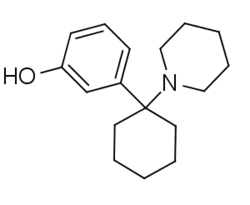3-HO-PCP
3-Hydroxyphencyclidine (3-HO-PCP) is a dissociative of the arylcyclohexylamine class related to phencyclidine (PCP) that has been sold online as a designer drug.[1][2]
 | |
| Clinical data | |
|---|---|
| Other names | 3-Hydroxyphencyclidine; 3-OH-PCP; PCP-3-OH |
| Legal status | |
| Legal status |
|
| Identifiers | |
| |
| CAS Number |
|
| PubChem CID | |
| ChemSpider | |
| UNII | |
| CompTox Dashboard (EPA) | |
| Chemical and physical data | |
| Formula | C17H25NO |
| Molar mass | 259.393 g·mol−1 |
| 3D model (JSmol) | |
| |
| |
Pharmacology
3-HO-PCP acts as a high-affinity uncompetitive antagonist of the NMDA receptor via the dizocilpine (MK-801) site (Ki = 30 nM).[3][4] It has much higher affinity than PCP for this site (Ki = 250 nM, for comparison; 8-fold difference).[4] The drug also has high affinity for the μ-opioid receptor (MOR) (Ki = 39–60 nM),[3][4][5][6] the κ-opioid receptor (KOR) (Ki = 140 nM),[5] and the sigma σ1 receptor (Ki = 42 nM; IC50 = 19 nM),[5][7][8][9] whereas it has only low affinity for the δ-opioid receptor (Ki = 2,300 nM).[5] The high affinity of 3-HO-PCP for opioid receptors is unique among arylcyclohexylamines and is in contrast to PCP, which has only very low affinity for the MOR (Ki = 11,000–26,000 nM; 282- to 433-fold difference) and the other opioid receptors (Ki = 4,100 nM for the KOR and 73,000 nM for the DOR).[4][5]
Although it was hypothesized that 3-HO-PCP might be a metabolite of PCP in humans, there is no evidence that this is the case.[10][11]
Chemistry
3-HO-PCP is an arylcyclohexylamine.[3] Close analogues of 3-HO-PCP include PCP, 3-MeO-PCP, 4-MeO-PCP, 3-MeO-PCMo, and somewhat more distantly ketamine, methoxyketamine, 3-MeO-PCE, methoxetamine and 4-(dimethylamino)-4-(p-tolyl)cyclohexanone.[3]
Society and culture
Legal status
On October 18, 2012 the Advisory Council on the Misuse of Drugs in the United Kingdom released a report about methoxetamine, saying that the "harms of methoxetamine are commensurate with Class B of the Misuse of Drugs Act (1971)", despite the fact that the act does not classify drugs based on harm. The report went on to suggest that all analogues of MXE should also become class B drugs and suggested a catch-all clause covering both existing and unresearched arylcyclohexamines, including 3-HO-PCP.[12]
References
- Morris, H.; Wallach, J. (2014). "From PCP to MXE: a comprehensive review of the non-medical use of dissociative drugs". Drug Testing and Analysis. 6 (7–8): 614–632. doi:10.1002/dta.1620. PMID 24678061.
- Davidsen, Anders Bork; Mardal, Marie; Johansen, Sys Stybe; Dalsgaard, Petur Weihe; Linnet, Kristian (April 2020). "In vitro and in vivo metabolism and detection of 3-HO-PCP, a synthetic phencyclidine, in human samples and pooled human hepatocytes using high resolution mass spectrometry". Drug Testing and Analysis. doi:10.1002/dta.2807. ISSN 1942-7611. PMID 32311838.
- Morris H, Wallach J (2014). "From PCP to MXE: a comprehensive review of the non-medical use of dissociative drugs". Drug Test Anal. 6 (7–8): 614–32. doi:10.1002/dta.1620. PMID 24678061.
- Kamenka JM, Chiche B, Goudal R, Geneste P, Vignon J, Vincent JP, Lazdunski M (1982). "Chemical synthesis and molecular pharmacology of hydroxylated 1-(1-phenylcyclohexyl-piperidine derivatives". J. Med. Chem. 25 (4): 431–5. doi:10.1021/jm00346a019. PMID 6279847.
- Johnson N, Itzhak Y, Pasternak GW (1984). "Interaction of two phencyclidine opiate-like derivatives with 3H-opioid binding sites". Eur. J. Pharmacol. 101 (3–4): 281–4. doi:10.1016/0014-2999(84)90171-7. PMID 6088255.
- Itzhak Y, Kalir A, Sarne Y (1981). "On the opioid nature of phencyclidine and its 3-hydroxy derivative". Eur. J. Pharmacol. 73 (2–3): 229–33. doi:10.1016/0014-2999(81)90097-2. PMID 6273187.
- Itzhak Y, Hiller JM, Simon EJ (1985). "Characterization of specific binding sites for [3H](d)-N-allylnormetazocine in rat brain membranes". Mol. Pharmacol. 27 (1): 46–52. PMID 3965930.
- Itzhak Y (1987). "[3H]PCP-3-OH and (+)[3H]SKF 10047 binding sites in rat brain membranes: evidence of multiplicity". Eur. J. Pharmacol. 136 (2): 231–4. doi:10.1016/0014-2999(87)90715-1. PMID 3036548.
- Itzhak Y (1988). "Pharmacological specificity of some psychotomimetic and antipsychotic agents for the sigma and PCP binding sites". Life Sci. 42 (7): 745–52. doi:10.1016/0024-3205(88)90646-7. PMID 2893238.
- Holsztynska EJ, Domino EF (1985). "Biotransformation of phencyclidine". Drug Metab. Rev. 16 (3): 285–320. doi:10.3109/03602538508991437. PMID 3914938.
- Holsztynska EJ, Domino EF (1986). "Quantitation of phencyclidine, its metabolites, and derivatives by gas chromatography with nitrogen-phosphorus detection: application for in vivo and in vitro biotransformation studies". J Anal Toxicol. 10 (3): 107–15. doi:10.1093/jat/10.3.107. PMID 3724069.
- "(ACMD) Methoxetamine Report (2012)" (PDF). UK Home Office. 2012-10-18. p. 14. Retrieved 2015-06-24.
- "Elva nya ämnen klassas som narkotika eller hälsofarlig vara" (in Swedish). Folkhälsomyndigheten. 28 June 2018.
- Riksdagsförvaltningen. "Förordning (1992:1554) om kontroll av narkotika". riksdagen.se (in Swedish).
- "Verordnung des EDI vom 30. Mai 2011 über die Verzeichnisse der Betäubungsmittel, psychotropen Stoffe, Vorläuferstoffe und Hilfschemikalien (Betäubungsmittelverzeichnisverordnung, BetmVV-EDI)" (in German). Der Bundesrat.